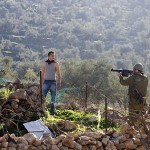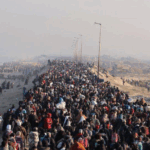Media Language and War: Manufacturing Convenient Realities
By RAMZY BAROUD
In the competitive world of media today, swift and conveniently selective reporting is of prime importance. GoogleNews, for example, claims to scan 4,500 news sources, of which only a few are highlighted as main stories. There are thousands of similar services, all competing to produce a story in the fastest time. Thorough – and thus slower – reporting is relegated and crucial information often appears too little too late.
The Iraq story, which has occupied a huge proportion of headline news for years, serves as a good example of this.
On February 1st, only a few minutes apart, two Iraqi women detonated themselves in two crowded pet markets in the Iraqi capital. Authorities said that 98 people were reportedly killed and 200 were wounded. Eyewitnesses reported a grizzly scene where human and animal body parts littered the streets, hundreds of feet away from the blasts.
Any thorough analysis of the story would have to examine several related factors. First, it would need to juxtapose the high death toll with US and Iraqi governments’ reports of ‘calm’ in the Baghdad area. The claim of a ‘return to normalcy’ in the Iraqi capital has been propagated for months, as a way of validating US President’s Bush’s military ‘surge’. Even if we buy into the questionable statistics aimed at hyping the positive outcome of the surge – questionable because they are only promoted by US and Iraqi military sources, with vested interests in downplaying the seriousness of the ‘insurgency’ – the violence seems to have shifted from the capital into northern areas, especially Mosul.
Instead of admitting failure in halting the violence which has plagued Iraq since the US occupation of 2003, US and Iraqi authorities resort to a continued and violent language to confuse and distract from the real issues.
This is how Alissa J. Rubin began her article for the New York Times (January 31): “The unsettled situation in northern Iraq continued Wednesday as Iraqi troops massed in Mosul to fight Sunni Arab extremists”. This is a brilliant way to divert attention of the story from the failure of the surge to manipulate other values, and lumping these values to create a completely fallacious association: “Sunni Arab extremists.”
Rubin further quotes an Iraqi defence ministry spokesman as claiming that the goal of the military operation is to “oust Al-Qaeda in Iraq from the city and prevent its fighters from returning.”
The entry statements contain a dangerously inaccurate linkage between Arabs (an increasing oppressed monitory in the Iraqi city), Sunnis (the ‘remnants of the Saddam regime’ as mindlessly parroted by the media), extremists of the previous group and al-Qaeda. The New York Times story – which often sets the standards for reporting in other major US publications – will have laid the prefect foundation to justify future ethnic cleansings of Sunni Arabs from the city, should the ‘military operation’ succeed in ‘driving out’ al-Qaeda militants (the numbers of which are inflated whenever such exaggeration is necessary).
Returning to the Baghdad markets’ bombings, the response to this tragedy was predictably misleading. The Iraqi government issued the usual, if somewhat bizarre statement, and US officials, including Secretary of State Condoleezza Rice made fiery condemnations. Enough material was gathered within the hour to inundate us with hundreds of ‘fresh’ news stories, which were mostly a rehash of the official statements made in Baghdad’s Green Zone or in Washington.
CNN online opened one of its articles, made available soon after the market bombings, with: “Two mentally disabled women were strapped with explosives Friday and sent into busy Baghdad markets, where they were blown up by remote control.”
The allegation was attributed to an Iraqi government official later in the statement.
The Iraqi official said that “people referred to the bomber at central Baghdad’s al-Ghazl market as the "crazy woman" and that the bomber at a second market had an unspecified birth disability.”
Who are these ‘people’? Did the CNN reporter examine the legitimacy of that claim by interviewing any of them’?
The involvement of women in this sort of violence is often a critical addition to the story, especially for Western readers. Readers tend to pause longer when they hear of a suicide bomber who was also a mother. They may feel an urge to learn more about the life of such a woman. Was she an inmate in Abu Ghraib? Tortured? Raped? Did she lose a family member to the US war, to the Iraqi death squads?
What do the bombings tell us about the security situation in Baghdad, the success or failure of the ‘surge’ or the war which is driving people to suicide in its most brutal manifestations?
Apparently, it tells us nothing.
But Lt. Col. Steve Stover, spokesman for the Multi-National Division-Baghdad has an explanation that seems, at least from the point view of CNN much more relevant than the seemingly unimportant questions above. "By targeting innocent Iraqis, they (those who dispatched the ‘mentally disabled’ women suicide bombers) show their true demonic character." Thus, CNN headline: “’Demonic’ militants sent women to bomb markets in Iraq.” In Western media language, Arab women are perpetually oppressed victims, and they must maintain that role for the story to read right. Thus, the women bombers cannot be viewed themselves as extremists, but as victims in the hands of extremists.
Within hours the buzz words on online news were ‘mentally disabled’ and ‘demonic’.
But what does ‘demonic’ mean exactly? What real issues does it address? And why should such an irrelevant outburst define the deadliest bombing in Baghdad in months?
Focusing on such extraneous associations – mindless, mad, demonic women, possessed and acting on the behest of bearded and cunning al-Qaeda ‘Arab Sunni, extremists’ – does much more than simply distract from the many military and policy failures in Iraq. It helps create a parallel universe to that of the real world, thus presenting a substitute image that shapes and reshapes the perceptions and imaginations of faraway news consumers.
The ‘real world’ – whether that of Iraq, Palestine, Burma, Kenya or any other – is a world that, although seemingly chaotic, is very much rational. It is predicated on the values of cause and affect. What may seem ‘demonic’ and ‘mad’ to a non-media person should not appear the same to a journalist. The latter’s responsibility is to narrate, contextualize and deconstruct with an independent and critical eye, not merely reiterate what has been told to him by ‘official sources’.
The corporate media’s depiction of the Gaza story which has been unfolding for months might be summed up in one overriding headline: Hordes of Palestinian Breach Gaza Border with Egypt, Israel Concerned over Its Security.
The imprisonment of 1.5 million Palestinians in Gaza – where poverty stands at 79 percent and unemployment hovers around a similar number, and where the majority of the population is ‘food insecure’ according to United Nations agencies – should have been depicted first and foremost as a humanitarian disaster compelled by an Israeli siege. The dates related to the successive stages of the siege follow a line of Israel’s political, not ‘security’ logic. Any reasonable timeline of recent events could easily verify that (the formation of the Hamas government in March 2006, the ousting of the pro-Israeli Palestinian security apparatus in June 2007 and so on being followed by dramatic Israeli moves to tighten the siege on Gaza, Hamas’ stronghold).
But little of that seemed relevant to the way the Gaza story was amply reported. Like the Iraq story, where the two main trusted sources are the occupation and its puppet Iraqi government, any story of relevance to Israel and Palestine has to be validated by the official Israeli source and to a lesser but growing extent by their allies among Palestinians. The rest are ‘extremist’, radical and hell-bent on the destruction of the ‘Jewish state.’ Note how the Jewishness of Israel is often emphasised whenever the word ‘destruction’ or similar words are infused.
This is what Bridget Johnson wrote in the Seattle PI (January 29) chastising the United Nations’ Human Rights Council for its condemnation of Israel’s siege on Gaza: “There was zero mention of Hamas’ continued rocket attacks on Israel — which preceded the cutoff of supplies that has caused such an uproar — or Hamas’ refusal to renounce violence against and attempted destruction of the Jewish state.”
The claims were preposterous – especially that of a small group’s ‘attempted destruction’ of a country saturated with nuclear arms. The words ‘destruction’ and ‘Jewish state’ are simply passed as an innocent ‘opinion’, read by thousands of Americans. There are many notable omission as well. Hamas has repeatedly called for a mutual ceasefire, that was also repeatedly rejected or simply ignored by Israel (in the guise of ‘not negotiating with terrorists’). The siege followed the democratic elections of Hamas, not the rocket attacks, the intensity of which corresponded with the number of Palestinians killed in Gaza. Also conveniently missed is the fact that Palestinians rockets have killed 10 Israelis in several years. The killing of any civilian anywhere is tragic, but the facts are rarely contextualised by the media. The number of Palestinians killed in Gaza as a result of Israeli army attacks since the Annapolis ‘peace’ conference two months ago is estimated at 149. Several folds were killed in Gaza since the siege started early 2006. Over 60 have died since June 2007 as a result of either lack of medicines or Israel’s refusal to allow them entry to better equipped hospitals in the West Bank. This is only the tip of the iceberg since human suffering cannot only be measured by those who die, but also those who continue to live in perpetual suffering. For Johnson, this is irrelevant, since this is not about right and wrong, but a war of language. To win the, one must have command over language – and the way it’s manipulated – and access to platforms that reach the largest number of readers. An easy recipe to victory is an intentional mix of such words as Islamic extremism, al-Qaeda, Hamas, Jewish state, security, destruction, right to exist, juxtaposed with images or clips of angry Palestinian youth burning Israeli and American flags, ‘side-by-side’, and you will have an American public and government standing in eternal solidarity with Israel.
While most US politicians are self-seeking, power hungry and would do whatever it takes to be elected, the average American, unlike what it may seem, is not born ‘pro-Israel’, and ‘anti-Palestinian.’ Most Americans are pro the manufactured, yet misleading image of Israel that reaches their homes through television, wait at their doorsteps in the morning and is beamed to them through the web. Israel has mastery over the language of the Western media, which, again, helped create a paralleled universe that has little relation to reality. That alternative universe only exist on the pages of New York Times, the images of CNN, and the blabber of Fox News ‘experts’. According to that narrative, Palestinians, are, like the Iraqi women suicide bombers, ‘demonic’, ‘mad’, ‘extremist’, ‘irrational’, self hating, and all the rest.
To recognize reality the way it is, one has to re-examine language. While a critical reader is essential, the task starts in the hand of a journalist, who must understand his topic not based on simple ‘facts’ and perceptions. Simple facts lead to simple conclusions: Sunnis extremists, mad Mullah, unruly Palestinians, besieged Israel. Every story can be told in three different ways: two by the two main conflicting parties, and a third by the journalist himself. The journalist must not compromise on his independence, must not buy into jargons, mantras, and turn into another official spokesperson. To convey a version of a story that is as close the true story as possible, a media person has to comprehend the context himself, analyse the motives and follow the line of logic: cause and affect, then, impart his new realizations – free of self-censorship, coercion or intimidation. Otherwise, the true story will always be shelved in favour of re-written official statements and repackaged government and military press releases, falsely presented as ‘accurate’, ‘independent’ and ‘impartial’. Mindlessly repeating these official discourses may be easier and more profitable, but it will make no helpful contribution to the field of journalism, and to any possibility of truth and justice.
-Ramzy Baroud (www.ramzybaroud.net) is an author and editor of PalestineChronicle.com. His work has been published in many newspapers and journals worldwide. His latest book is The Second Palestinian Intifada: A Chronicle of a People’s Struggle (Pluto Press, London).










































0 Comments